
Wow, more 'myrids described in "Review of the southern African slender stonebashers, genus Heteromormyrus Steindachner 1866 (Teleostei: Mormyridae), with description of six new species" by Mutizwa, Kadye, Bragança & Chakona, open access in J Fish Biol. doi.org/10.1111/jfb....
23.09.2025 18:52 — 👍 13 🔁 4 💬 0 📌 1
Loved this book. Gives one a sense that human progress in understanding the living world is so embedded in culture. Perhaps we’re on the eve of a Buffonian Renaissance.
10.09.2025 02:11 — 👍 1 🔁 1 💬 0 📌 0

Who knew such cuteness was lurking in the eastern Pacific abyssal zone? This is the bumpy snailfish, Careproctus colliculi n. sp., described by Gerringer et al. in Ichs & Herps., sequences now in GenBank. doi.org/10.1643/i202...
03.09.2025 18:07 — 👍 13 🔁 5 💬 0 📌 1

Can speciation leave essentially no phylogenetic signal? A fascinating study of the Caribbean hamlet (Hypoplectrus: Serranidae) radiation by Helmkampf et al. in Science. www.science.org/doi/full/10....
30.07.2025 14:26 — 👍 24 🔁 11 💬 0 📌 0
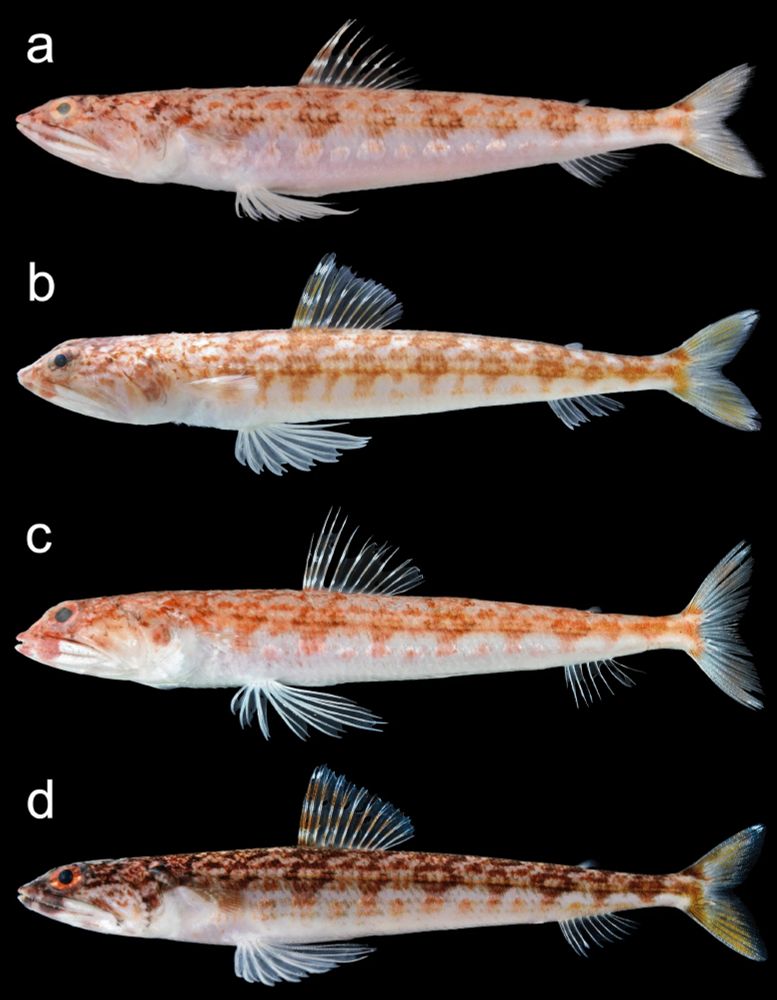
Today at GenBank: sequences from the types of Synodus lautus sp. nov. from "A new species of Synodus from southern Japan, with a redescription of Synodus usitatus Cressey 1981 (Teleostei: Aulopiformes: Synodontidae)" from Furuhashi & Motomura in Ichthyol. Res. link.springer.com/article/10.1...
23.05.2025 17:22 — 👍 8 🔁 1 💬 0 📌 0

Today at GenBank, sequences from the type series of new species Scorpaenopsis gigas (Scorpaenidae) from the Indo-West Pacific, courtesy of Matsumoto & Motomura, published in Ichthyological Research. link.springer.com/article/10.1...
08.05.2025 20:51 — 👍 6 🔁 3 💬 0 📌 0
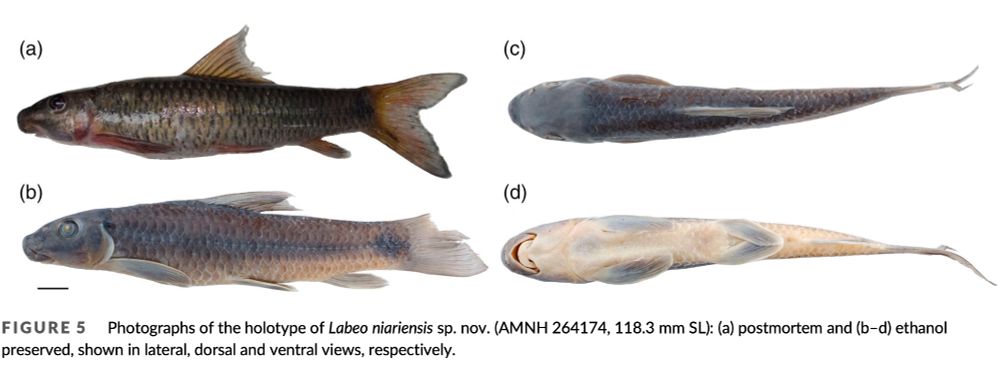
Today at GenBank: sequences from the holotype of Labeo niariensis sp. nov. from the Niari River of R. Congo, courtesy of Liyandja & Stiassny in J. Fish Biol. (open access) onlinelibrary.wiley.com/doi/10.1111/...
23.04.2025 14:14 — 👍 4 🔁 2 💬 0 📌 1

FIGURE 4 | Estimated mean dates for biogeographic events in Erythrinidae on tectonically active (Western) and passive (Eastern) continental
margins. (A) Phylogenies of species in erythrinid genera from Figure 2A. Numbered circles represent biogeographic events dated using the geological
literature (Table S3). Lettered tip labels represent biogeographic areas on the map. Red numbers at tree nodes represent mean divergence time esti-
mates (Ma). (B) Lineage-age distribution of biogeographic events for clades in Panel A. Estimates are reported for minimum, median and maximum
(mean dates from Figure 1) event age (Table S3). Ages of tectonic uplifts are indicated by horizontal rose bars. Note pulsed-age distribution of bio-
geographic events in clades on the active Western margin, while the more continuous age distribution of events on the passive Eastern margin. Note
opposite directions of watershed migration and geodispersal routes. Fish photographs: Hoplias and Erythrinus (Martin Taylor) and Hoplerythrinus
(Jorge García-Melo)
Landscape Evolution Drives Continental Diversification in
Neotropical Freshwater Fishes of the Family Erythrinidae
(Teleostei, Characiformes)
Conde-Saldaña et al. @gymnotus.bsky.social 2025 Journal of Biogeography
doi.org/10.1111/jbi....
Shows connection between evolutionary history and geology.
04.04.2025 09:32 — 👍 20 🔁 8 💬 1 📌 1
Can you email me? jpsullivan65@icloud.com
31.03.2025 21:43 — 👍 1 🔁 0 💬 1 📌 0
Sure. Can we chat on a different app, or is there a chat feature on this?
31.03.2025 21:27 — 👍 0 🔁 0 💬 0 📌 0
YouTube video by PeerJ
What ‘unexplored’ means: Mapping regions with digitized natural history records
Very proud of this paper led by @lsu.bsky.social students where we examine what ‘Unexplored’ means in a natural history context - we recommend ‘biodiversity blindspots’ instead for places that lack digitized public data
Paper here peerj.com/articles/185...
Video abstract youtu.be/QZ8wUrgJEao
17.01.2025 12:32 — 👍 61 🔁 20 💬 0 📌 2
Turns out the Snail Darter, which halted a TVA dam’s construction in the first major test of the Endangered Species Act, was never a distinct species. All species descriptions are hypotheses open to testing.
03.01.2025 18:23 — 👍 5 🔁 2 💬 0 📌 1
Do you actually work in that amazing building?
23.12.2024 20:26 — 👍 0 🔁 0 💬 1 📌 0

Hey mormyrophiles: Something just made me very happy and I want to share it with you. ChatGPT makes graphing single and multiple EOD waveform files produced by Mormyroscope and taking data from them super easy! Read about it here: mormyrids.efishgenomics.com/en/node/666
22.12.2024 20:24 — 👍 4 🔁 1 💬 0 📌 0

Ancient Egyptian sculpture of a mormyrid fish.

Korean painted screen depicting fishes in a pond.

Still life showing skate, dogfish, and other sea creatures.

"Watson and the Shark"; painting depicting man struggling in water and a shark about to attack. Several men on a dinghy attempt to spear the shark/rescue the man.
Fishes of the Detroit Institute of Arts.
21.12.2024 01:43 — 👍 17 🔁 3 💬 2 📌 0
The "Oxyrhynchus fish" (Mormyrus god fish) itself is worth a visit to the Motor City. Would love to know how many of these there are in U.S. museums.
21.12.2024 04:09 — 👍 1 🔁 0 💬 0 📌 0
 21.12.2024 02:40 — 👍 3 🔁 0 💬 0 📌 0
21.12.2024 02:40 — 👍 3 🔁 0 💬 0 📌 0
Low engagement is not the issue. A journalist baselessly called a pedophile and multiple death threats proffered. No consequences. Not off to a promising start.
21.12.2024 02:01 — 👍 0 🔁 0 💬 0 📌 0
It probably hasn't been. I'm mostly here for the fish. But when I read the story above my blood boils. Yours doesn't?
21.12.2024 01:28 — 👍 0 🔁 0 💬 1 📌 0
I wanted to like you Bluesky, I really did. You're a young platform still finding its legs. But if this is designed to be a "safe space" for people with views far left of center with no viewpoint diversity and you can't shut down murder threats against journalists my time here will be short.
21.12.2024 01:16 — 👍 0 🔁 0 💬 1 📌 0
Two postdocs available to study cryptobenthic fishes
Simon Brandl's postdoc in Texas, with an emphasis in ecology
static1.squarespace.com/.../Postdoc_...
Luke Tornabene's postdoc in Washington, with an emphasis in systematics
static1.squarespace.com/.../Pursuit+....
#ichthyology #TeamFish
19.12.2024 15:28 — 👍 26 🔁 20 💬 3 📌 1

Tagliacollo et al. mine GenBank for 51 markers for 5,984 taxa and produce a "Time-calibrated phylogeny of Neotropical freshwater fishes" in Frontiers in Bioinformatics. A testament to the value of the database I help maintain for biodiversity studies. frontiersin.org/journals/bio...
19.12.2024 14:32 — 👍 13 🔁 7 💬 1 📌 1
Outrageous. I will leave this stupid platform if this happens again. There, that should fix it.
07.12.2024 01:54 — 👍 0 🔁 0 💬 0 📌 0
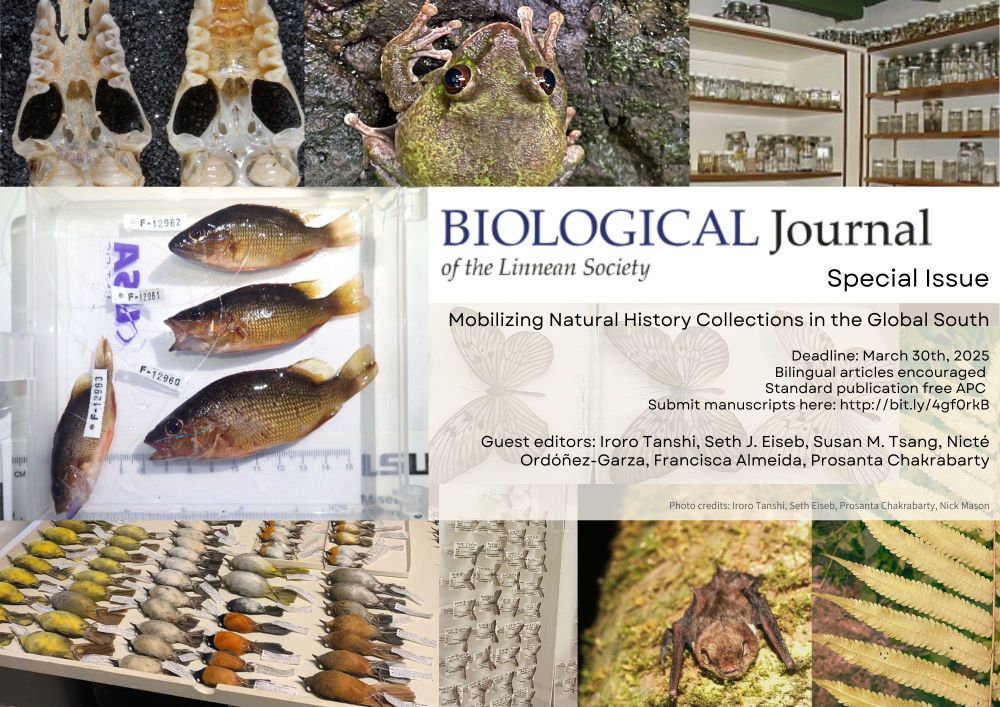
On behalf or the Editor-in-Chief and my fellow Guest Editors, I am pleased to announce a special issue in the Biological Journal of the Linnean Society titled Mobilizing Natural History Collection in the Global South. Details are available on the journal website https://academic.oup.com/biolinnean/pages/mobilizing-natural-history-collections
Key details
Submissions are welcomed from authors around the globe, but the manuscript must include research/findings on Global South NHCs (including the lack of infrastructure or NHCs). Global South researchers are particularly encouraged to submit to the issue. Accepted manuscripts in this special issue will be a standard publication that is free of APC (Article Publication Charge). Bilingual articles are encouraged, with one non-English version as supplementary material.
Submission close: 31 March 2025
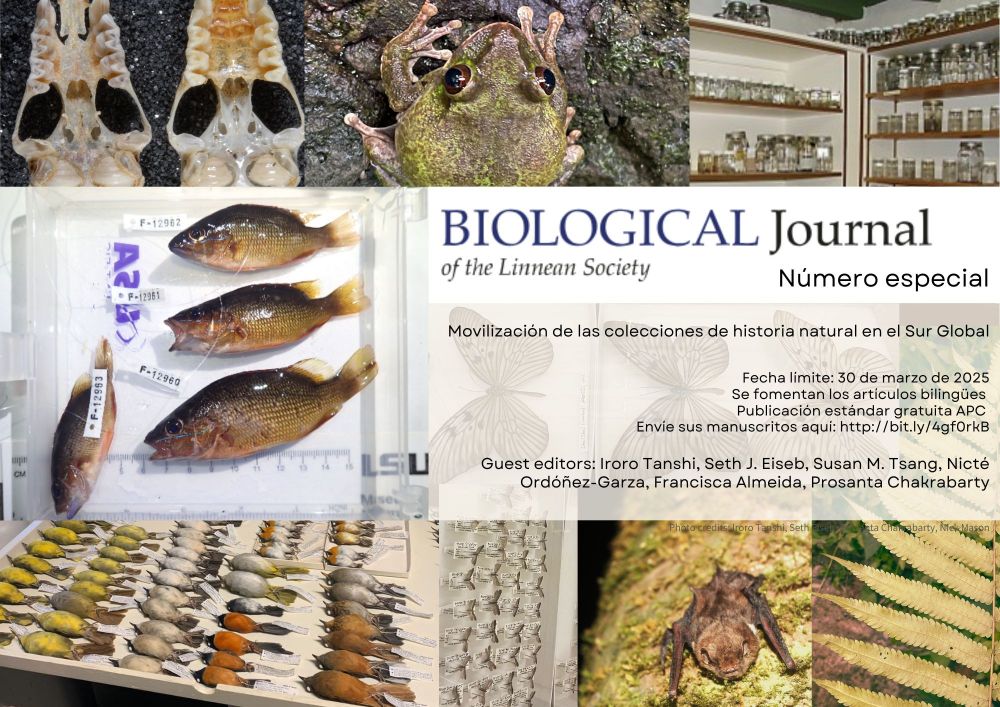
Chers collègues,
Au nom du rédacteur en chef et de mes collègues éditeurs invités, j'ai le plaisir d'annoncer un numéro spécial du Biological Journal of the Linnean Society intitulé Mobilizing Natural History Collection in the Global South (Mobiliser les collections d'histoire naturelle dans le Sud). Les détails sont disponibles sur le site web du journal https://academic.oup.com/biolinnean/pages/mobilizing-natural-history-collections
Principaux détails
Les soumissions d'auteurs du monde entier sont les bienvenues, mais le manuscrit doit inclure des recherches/constatations sur les collections d'histoire naturelle du Sud (y compris le manque d'infrastructures ou de collections d'histoire naturelle). Les chercheurs des pays du Sud sont particulièrement encouragés à participer à ce numéro. Les manuscrits acceptés dans ce numéro spécial feront l'objet d'une publication standard exempte de frais de publication d'article (APC). Les articles bilingues sont encouragés, avec une version non-anglaise comme matériel supplémentaire.
Date limite de soumission : 31 mars 2025
J'ai également joint une annonce et un PDF avec des détails supplémentaires. Les versions non anglaises (français, espagnol et portugais) sont incluses (avis de non-responsabilité : basé sur des traducteurs en ligne). N'hésitez pas à diffuser largement l'information et à nous faire part de vos questions.
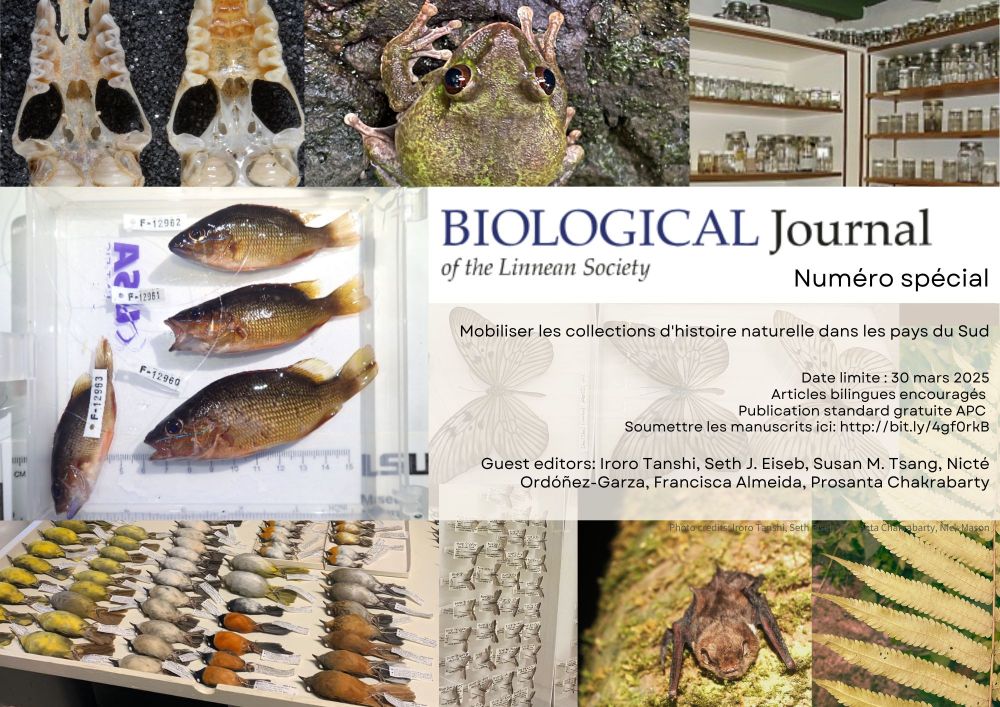
stimados colegas,
En nombre del Editor Jefe y de mis colegas Editores Invitados, me complace anunciar la publicación de un número especial en la Revista Biológica de la Sociedad Linneana titulado Movilizando la Colección de Historia Natural en el Sur Global. Los detalles están disponibles en el sitio web de la revista https://academic.oup.com/biolinnean/pages/mobilizing-natural-history-collections
Detalles principales
Se aceptan colaboraciones de autores de todo el mundo, pero el manuscrito debe incluir investigaciones o hallazgos sobre las CNH del Sur Global (incluida la falta de infraestructuras o CNH). Se anima especialmente a los investigadores del Sur Global a participar en este número. Los manuscritos aceptados en este número especial serán una publicación estándar libre de APC (Article Publication Charge). Se fomentarán los artículos bilingües, con una versión en lengua no inglesa como material suplementario.
Plazo de presentación: 31 de marzo de 2025
También he adjuntado un anuncio y un PDF con detalles adicionales. Se incluyen versiones en otros idiomas (francés, español y portugués) (descargo de responsabilidad: basado en traductores en línea). Por favor, difúndalo y no dude en hacernos llegar sus preguntas.
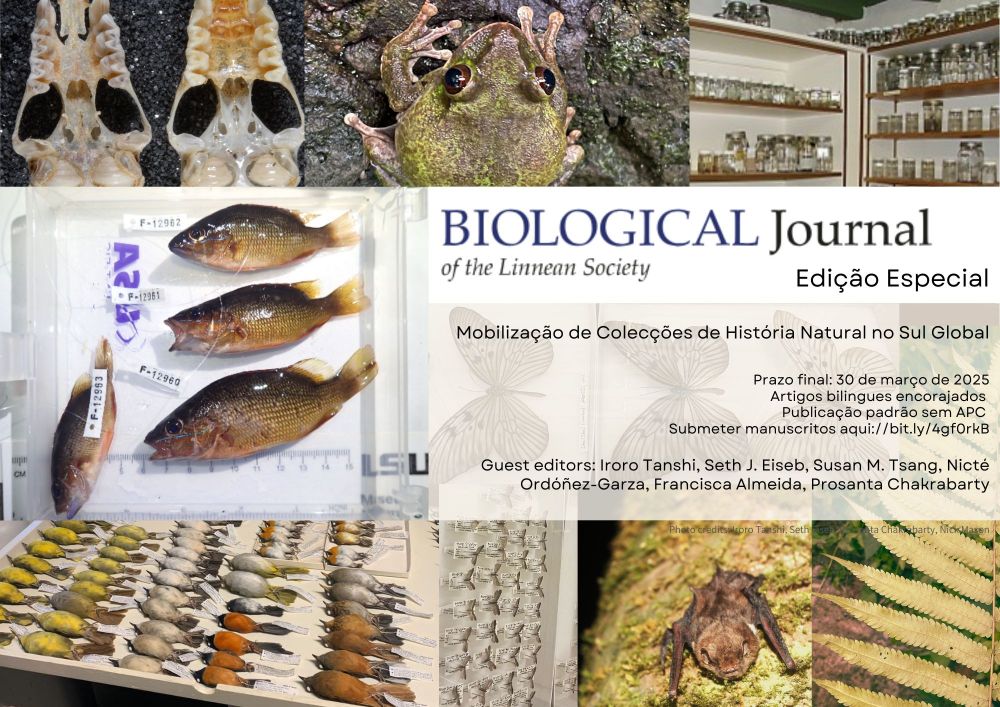
Caros Colegas,
Em nome do Editor-Chefe e dos meus colegas Editores Convidados, tenho o prazer de anunciar uma edição especial do Biological Journal of the Linnean Society intitulada Mobilizing Natural History Collection in the Global South. Os pormenores estão disponíveis no sítio Web da revista https://academic.oup.com/biolinnean/pages/mobilizing-natural-history-collections
Detalhes principais
São bem-vindas submissões de autores de todo o mundo, mas o manuscrito deve incluir investigação/conclusões sobre NHCs do Sul Global (incluindo a falta de infra-estruturas ou NHCs). Os investigadores do Sul Global são particularmente encorajados a submeter trabalhos para esta edição. Os manuscritos aceites para esta edição especial serão uma publicação padrão isenta de APC (Taxa de Publicação de Artigos). Os artigos bilingues são encorajados, com uma versão em língua não inglesa como material suplementar.
Encerramento da submissão: 31 de março de 2025
Anexei também um anúncio e um PDF com pormenores adicionais. Estão incluídas versões não inglesas (francês, espanhol e português) (aviso: com base em tradutores em linha). Partilhe amplamente e não hesite em enviar-nos quaisquer perguntas.
Advertisements for the special issue in English, French, Spanish and Portuguese ... please encourage folks from the Global South to submit a manuscript to this special issue.
03.12.2024 14:10 — 👍 9 🔁 5 💬 0 📌 1
Brazilian ichthyologist. Exploring fish diversity, phylogeny, and biogeography.
Currently at Federal University of Rio de Janeiro, Brazil
MS student in the Moran Lab at Texas A&M University
Freshwater fish behavior, ecology, and conservation
#Teamfish
PhD student at the University of Exeter @uniexecec.bsky.social
Sensory processing and signal perception during mate choice interactions 👁️ 🐟
Assistant Professor in Fisheries Biology, University of Vermont | Population genetics, ecology, and human dimensions of fisheries
https://bernoslab.wordpress.com/
Berlin-based biodiversity scientist. #ichthyology #biodiversity #conservation #urbanbiodiversity #urbanecology #mothing #photography
Expat Kiwi, Professor of Taxonomy at Glasgow University, inclined to say that something sucks at every available opportunity. Biodiversity informatics, phylogeny, knowledge graphs. I also run the @evoldir.bsky.social bot.
Vertebrate evolutionary biologist | Professor University of Michigan | Director & Curator UMMP | he/him/his
Earth resilience, tipping behavior, nonlinear thinking, stability analysis, climate change, photosynthesis, soil respiration, tree mortality, Fulbright Scholar
Patterson Scholar + Curator of Herpetology, California Academy of Sciences. National Geographic Young Explorer. I like frogs. A lot. she/her raynacbell.com
Large river ecologist, Director at the Illinois River Biological Station. My team and I specialize in large river ecology (long-term monitoring, restoration, and management). Lots of interests: otoliths, invasive species management, telemetry, rstats,...
Professor in Biology at Wilfrid Laurier University (Canada). My research interests are centered around #fish #physiology specifically ion and acid-base regulation. We also have an interesting line of research on the story of #stomach loss in fishes. 🐠🐟🦈🐡
random photo feed of wildlife photographer Oliver Lucanus, more at Belowwater.com or youtube.com/amazonbelowwater
I like fish + fishing and study both as professor for integrative fisheries management (IFishMan) at Humboldt-Universität and IGB in Berlin. Editor of Fish Fish. and Z. für Fischerei. Father of two and into independent music. Read more at www.ifishman.de
Idiot, slow down, slow down
PhD student at University of Iceland tracking juvenile cod in Icelandic nearshore habitats using Acoustic telemetry. Biodiversity. Spatial ecology. Marine conservation.
Science News from Academic Journals etc.
Biologist
@leibnizlib.bsky.social | #research | #ichthyology | #natureconservation | #taxonomy | #biodiversity | #water | #fishes
Aquatic Ecologist | Postdoc @LeibnizIGB & @FU Berlin | Res. Associate @stri_panama #Humboldtian | @WWFColombia















 21.12.2024 02:40 — 👍 3 🔁 0 💬 0 📌 0
21.12.2024 02:40 — 👍 3 🔁 0 💬 0 📌 0








